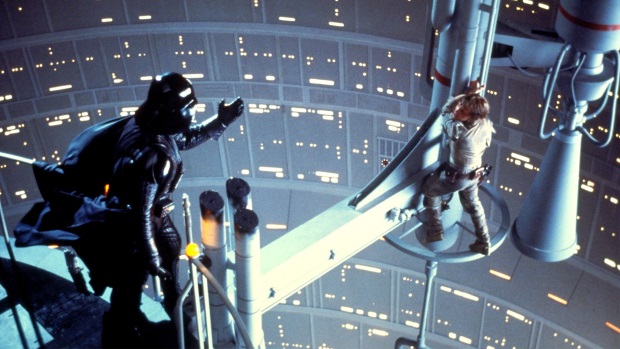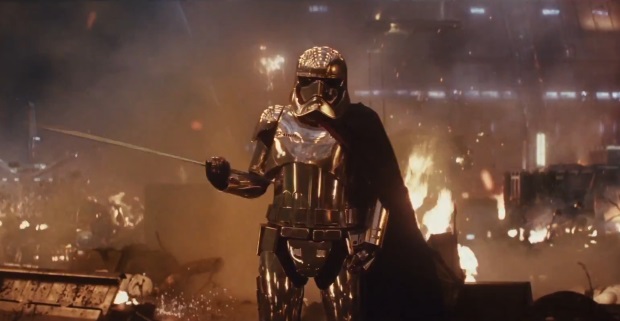Star Wars and the Strategic Use of Chasms
Wherever you go in the Star Wars universe, it seems that there's a big chasm to fall into...
This article comes from Den of Geek UK. It contains spoilers for basically all Star Wars films.
“He who fights with monsters should be careful lest he thereby become a monster. And if thou gaze long into an abyss, the abyss will also gaze into thee.”
Frederick Nietzsche – your edgy friend’s problematic fave – wrote this aphorism and series bible for Doctor Who (1987 onwards) in his popular stocking filler Beyond Good and Evil. Clearly though, Nietzsche never watched Star Wars, in which an abundance of abysses, chasms, clefts, fissures, rifts, cavities, gulfs, and voids don’t have much of two-way interfaces.
I don’t know about you, but I go about my day-to-day life interacting with almost zero chasms. Sometimes at the food court at the shopping centre there’s a 20 foot drop to the cart selling phone covers, but that’s about it. It just isn’t a feature of contemporary architecture, and I’m grateful for it.
A long time ago, in a galaxy far, far away however, man-made chasms are an essential feature of your standard living/workplace, especially if your workplace is a bit of a fascist allegory. You can’t have the bowels of something without the requisite piping, and so it is we see huge drops into unseeable depths throughout the Star Wars universe. Invariably, people fall into them, but lessons are not learned.

Indeed, Cloud City from The Empire Strikes Back clearly advertises its huge tumbling potential, appearing to have been designed based on Dylan Moran’s concept for the ideal body (“…a long, long tube with my arse way over there so I don’t have to deal with it”). This is not an isolated case. Every iteration of the Death Star we have seen has included a few big shafts, often involving the death of a major character. If you’re watching Star Wars, beware of Chekhov’s chasm. If you see one, something is going to fall into it, be it an exhaust port or the lower levels of Coruscant. An aspiring Jedi is bound to head down one, entering a strange fantastical dream, rich in imaginative imagery.
This means that, even if you had avoided spoilers, you had an inkling of Han Solo’s fate in The Force Awakens as soon as you realized there was a significant cleft for him to fall into. The Empire and its offshoots love constructing ineffable depths, using retractable bridges and eschewing safety designs such as walls and barriers.
The Last Jedi continues this aesthetic. Clock Snoke’s ship, with its sheer drops around everyday work areas, including in the Supreme Leader’s chambers. The First Order are clearly used to having these around, which leads to Phasma assuming Finn will fall to his death. There’s usually a handy chasm around, why wouldn’t there be one now?

Speaking as someone who works in admin, the Empire is a health and safety nightmare. I know there’s a stereotype of bureaucracy and nanny state around these policies, but if one person with a clipboard went around the Empire’s facilities, they could prevent the destruction of both Death Stars and the death of the Emperor. All it would take is some netting and a rail, especially as it’s still a construction site.
Contrast this with Rogue One, where Cassian Andor falls around thirty feet after getting shot, and ultimately survives in good enough health to climb up to the (very efficient) lifts and shoot the bad guy. Considering the abundance of chasms elsewhere (the scientific base on Eadu, for example, remembered to make sure there was a big drop available), if the Empire had actually installed a decent plummet on Scarif then the Rebellion would never have got the plans for the first Death Star.
It becomes clear that a significant part of the Empire’s failures comes from the poor use of chasms. They have them freely available when they don’t need any, and none when it’d be really useful. Phasma fails to kill Finn by improper use of chasms, and then falls into one herself. This chasm is on fire. On a side note, I hope to see Captain Phasma in the next film with no explanation of how she survived.

This does illustrate, though, that for all that both sides buy their ships from the same dealers, as long as the baddies’ aesthetics remain impractical, the rebels have got a chance. Look at their ships. Nothing to fall into dramatically there whatsoever. Clearly someone has gone around with a clipboard.
Some might say that rebellions are built on hope, or saving what you love, but basic research also demonstrates that they’re also built on solid foundations, sensible use of walls, and good, solid health and safety legislation (to be carried out quarterly).
